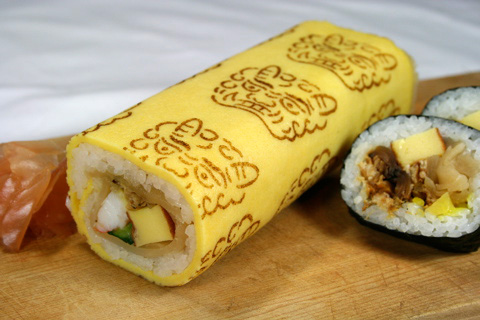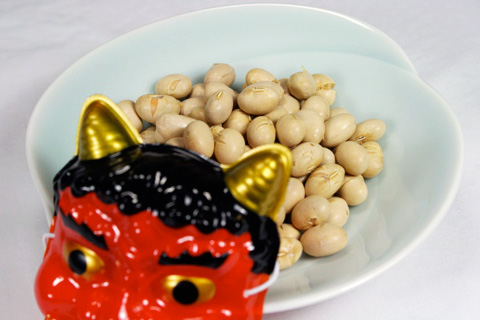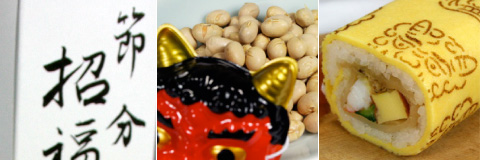TOKYO |
Feb 3 (Reuters) - Gobbling down a huge sushi roll in one go on Japan's February 3 end-of-winter festival is thought to bring good fortune -- just as long as you don't speak while you eat and remember to face the right way.
"Ehomaki," or "Lucky Direction" sushi rolls, are mammoth versions of the toothsome, seaweed-wrapped rice rolls that are a popular part of sushi meals. Roughly 6 cm (2.3 inches) in diameter and 20 cm (8 inches) long, they contain everything from egg, fish and vegetables to slices of fried pork cutlet.
The important thing is to take them in hand and eat, silently, while facing the proper direction -- this year, north-northwest.
Nobody really knows why or how the tradition evolved, though, only that it seems to have first appeared in the western city of Osaka.
"One of the theories for where Lucky Sushi Day came from is, well, men would make prostitutes in Osaka eat large sushi rolls and they'd watch that for a laugh," food analyst Minako Murakoshi told Reuters.
"There's some evidence for that but of course there are other theories as well."
A more likely explanation is that they were first whipped up by food stalls in Osaka in the mid-1800s. Then, a century later, a local seaweed retailer turned that into a regional tradition through sushi-eating contest and prizes for the largest sushi roll as a way to kick-start sales.
In more recent years, they've been seized upon by Japanese convenience store chains as a seasonal money spinner to fill the gap between Christmas and Valentine's Day.
Prior to this, February 3 -- or Setsubun -- was celebrated mainly by people throwing beans to chase demons out of their house, chanting "Out with demons, in with happiness."
But in 1989, retailer Seven Eleven launched a Lucky Sushi Day at one of its Osaka-area stores. The celebration was rolled out nationally in 1998.
"The Japanese are pretty keen on events associated with the seasons, like eating cake at Christmas or giving people chocolates on Valentine's Day," Murakoshi said.
"After Lucky Sushi Day, there'll be loads of chocolates for Valentine's Day out on the shelves, and consumers will be pulled in by that and end up buying lots of chocolates too."
At the top of Tokyo Tower, a popular tourist spot resembling the Eiffel Tower, people gathered to eat Lucky Sushi -- and struggled to say why.
"I think the tradition originally came from western Japan, but it's been promoted in all sorts of ways in Tokyo. Gradually everyone's started doing it," said Keiko Fuji, a Tokyo mother.
Others had more mundane concerns, such as how to actually eat the massive rolls.
"We cut it into smaller pieces and eat it that way," said 65-yea-old Yasuhiro Irie.
Traditionally, Lucky Sushi were filled with seven lucky ingredients, including egg, cucumber and eel. But the modern version includes some stuffed with spongecake, or even with bread in place of rice. (Editing by Elaine Lies, editing by Paul Casciato)
Setsubun: The Day Before Spring, Demons, How to Eat Eho-Maki and Throw Your Beans
Setsubun: The Day Before Spring, Demons, How to Eat Eho-Maki and Throw Your Beans (節分: 立春、恵方巻、炒り豆、豆撒き)
On February 3rd, people in Japan celebrate Setsubun, the coming of spring. Special sushi rolls called Eho-maki (恵方巻) and eaten while facing the auspicious direction for that year. After dinner, roasted soy beans, or iri-mame are thrown out the front door of the house to cast out demons (oni), disease and bad fortune and welcome spring and and a new year of good fortune.
Paku did some shopping at one of the major department stores in Kyoto and came over with some tasty Setsubun goodies.
Setsubun is associated with The Chinese New Year, or Lunar Calendar which was used for centuries in Japan, so this is a coming of spring festival as well as the traditional new year. It is still an important event in Japan. Setsubun properly refers to the day before the coming of any of the four season. So, this is actually, risshun (立春) , spring Setsubun.
Setsubun dinner is simple, sushi rolls (makizushi). The proper way to eat this dinner is to face a certain direction, this year it was south-east, and eat the entire sushi roll without stopping. Don’t speak, just make your wish! This takes longer than you might think, so you have time to wish for a lot!
Eho-maki, Iri-mame and Oni (demon) Mask
Eating the entire makizushi in one go is quite difficult and I would imagine that more than a few people have choked to death while eating their makizushi according to the rules.
This makizushi is called ehomaki (恵方巻) literally, ‘direction of blessing roll’, wrapped in egg is quite an innovation to my eyes. The oni is branded (yaki-in) on the sheet of egg that is used to wrap the sushi. While it is common to see a single yaki-in on various foods in Japan, usually egg based creations, we had never seen one like this where it covers the entire thing like this.
Someone must have invented a new machine, I thought!
Setsubun Sushi Rolls, Eho-maki – detail
Machine-made or not, it was one of the best damn makizishi I have ever had, and fun to eat!
It came packed in a cute little box to boot. Japanese put lots of energy and effort into packaging.
About those beans. The beans are roasted soybeans. They taste just fine if you are in to roasted soybeans, nothing to get real excited about, taste-wise.
What to do with the beans:
Iri-mame and an Oni (demon) Mask – detail
What you do here is put all the beans in a big bowl then each person counts out the number for your age, placing them in your own blog or plate. This is done after dinner.Then, together you count, one, two, three.. and eat one bean for each year.
This was actually the first time I had done this properly as Paku is a real traditional Japanese girl. Seeing my life as a plate of beans was strange.
As Paku was counting and we were eating beans, I was thinking in my mind the landmarks in my life that came to mind when I picked up each bean. First memories, first pet, t-ball, golden birthday, first kiss, — Paku was born –, lost my virginity, traveled abroad, graduated uni, came to Japan, turned 30.
As Paku was eating her last bean, she said out loud, “How long I have known you, darling!” Oh, sweet!
Some people eat one more bean, this is said to protect your from getting a cold and others say that it ensures a year of happiness.
Then with the remaining beans, you take them to the front door and say “Oni wa soto! Fuku wa uchi!” (鬼は外! 福は内!) Literally, “Oni out, good fortune in!” Then throw them out in the street. As this is the beginning of spring, some people say “Out with the old and in with the new!”
According to Wikipedia, in one region of Japan, they say something like “Oni‘s eyeballs — SMASH! SMASH!” I like that one!
I tried it out on Paku right away. As she was quietly reading after dinner I blurted out, “Paku’s eyeballs — SMASH! SMASH!”
Terrified, she looked at me like I was pointing a knife at her. I thought she was going to run away or call the police, maybe both! (The Japanese words are really scary.) I retorted, that I was just trying out what I learned on Wikipedia and that IS what they say in up in Fukushima Prefecture.
The throwing of beans, called Mame-maki (literally, bean scattering) dates back to ancient Japan. A Heian-era monk is said to have driven away a demon by throwing roasted beans at him/it. Ah, life must really have been simpler back then.
So there you have it, Setsubun. Ehomaki and roasted soybeans. Another fun Japanese festival intricately intertwined with food.
Eho-maki, Iri-mame and Oni (demon) Mask
notice the box in the background.

沒有留言:
張貼留言